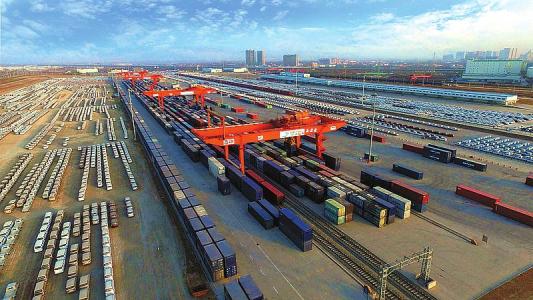Chinese SOEs accelerate participation in B&R construction

This year marks the fifth anniversary of the proposal of the Belt and Road Initiative. During these five years, cooperation under the initiative has been fruitful. China has signed Belt and Road cooperation agreements with over 80 countries and international organizations, and over 100 countries and international organizations have participated in the Belt and Road constructions.
In spite of the fruitful results, there are still difficulties and challenges along the way. China and the countries along the Belt and Road routes have been devoted to carrying forward cooperation to resolve concerns of enterprises through better policy coordination, improved facilities connectivity, and strengthening trade promotion mechanisms. This pushed more and more Chinese enterprises go global under the implementation of Belt and Road Initiative and particularly, Chinese state-owned enterprises (SOEs) play an important role among them.
BREAKING OUT OF MULTIPLE DILEMMAS
Belt and Road cooperation was faced with many challenges at the beginning, among which poor infrastructure posed a major restriction for economic development of countries along the Belt and Road routes. Therefore, there have seen the launch of more and more China Railway Express (CR Express) that cover an ever larger scope with the advancement of the Belt and Road Initiative.
Data showed that more than 9,000 trains of CR Express have been dispatched as of the end of this June, delivering nearly 800,000 TEUs of cargo. Routes of CR Express connect 48 Chinese cities with 42 cities in 14 European countries, and the network covers major areas of Eurasia.
As an important carrier and platform of the Belt and Road construction, CR Express has released the potentials of land logistics and trade channels between Asia and Europe, promoted economic and trade cooperation between China and other countries along the Belt and Road routes as well as some other European countries, and become an important part of connectivity construction.
In terms of supporting policies, China is devoted to optimizing business environment to resolve enterprises’ concern during going global. Tax authorities have been dedicated to deepening tax cooperation with Belt and Road countries and regions, removing tax barriers, reducing tax burdens to improve tax governance and facilitate smooth trade flow.
According to Liao Tizhong, director general at the International Tax Department of the State Administration of Taxation, as of April 2018, Chinese tax authorities had cooperated with 25 international organizations and regional tax administrations, established bilateral tax cooperation mechanism with 117 countries and regions, and signed tax agreements with 54 countries and regions along the Belt and Road. From 2015 to 2017, tax authorities had utilized the mutual negotiation mechanism under these tax agreements to carry out 211 bilateral tax negotiations, which reduced 12.878 billion yuan of double taxation for Chinese enterprises that went global and foreign enterprises that came to invest in China.
Data by the Ministry of Commerce showed that amount of newly-added investment from Chinese enterprises to 54 countries along the Belt and Road totaled 5.93 billion U.S. dollars in the first five months of this year, up 8.2 percent on year. The value of new contracts of projects in countries along the Belt and Road hit 36.22 billion U.S. dollars in the first five months, accounting for 42.4 percent of the total foreign contracted projects during the period.
SOES LEAD THE WAY IN B&R CONSTRUCTION
Peng Huagang, deputy secretary general of State-owned Assets Supervision and Administration Commission of the State Council (SASAC), said at a recent press conference that so far over 80 SOEs had undertaken 3,116 investment projects in countries along the Belt and Road, greatly boosting the local economic and social development.
SOEs achieved significant results in such aspects as infrastructure construction, energy cooperation and development, and international capacity cooperation under under Belt and Road Initiative, according to Xiao Yaqing, Chairman of SASAC.
For example, in the past five years, China Communications Construction Company Limited (CCCC) has invested in over 1,000 projects in countries and regions along the Belt and Road, signing new contracts worth more than 63 billion U.S. dollars, and planned over 20 development park projects, involving investment projects of nearly 5 billion U.S. dollars.
CCCC has built 155 bridges in countries and regions along the Belt and Road and designed and constructed 7 of the top 10 ports in the world. This company also built 95 deep water berths and provided 754 container cranes in Belt and Road countries and regions.
In addition, CCCC has built over 10,000 kilometers of roads, signed and implemented contracts of near 3,000 kilometers of railways in these countries and regions. They are helping local people live a better life and boost local economic and social development with their investment in roads and railways.
With strong business advantages in the whole industrial chain, China Energy Engineering Group Co., Ltd. (Energy China) provides customers with "one-stop" comprehensive solutions and full lifecycle management services. From 2014 to 2017, Energy China had signed contracts worth 300 billion yuan in countries along the Belt and Road, taking up more than 10 percent in the total value of contracts signed by Chinese enterprises in these countries.
SOEs play a leading role in Belt and Road construction, so they should bear responsibilities and set good examples, according to a senior manager at Energy China, noting that Energy China has given a full play to its business advantages in full industrial chain to serve the Belt and Road construction.


